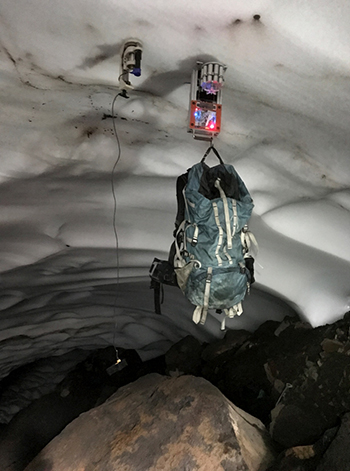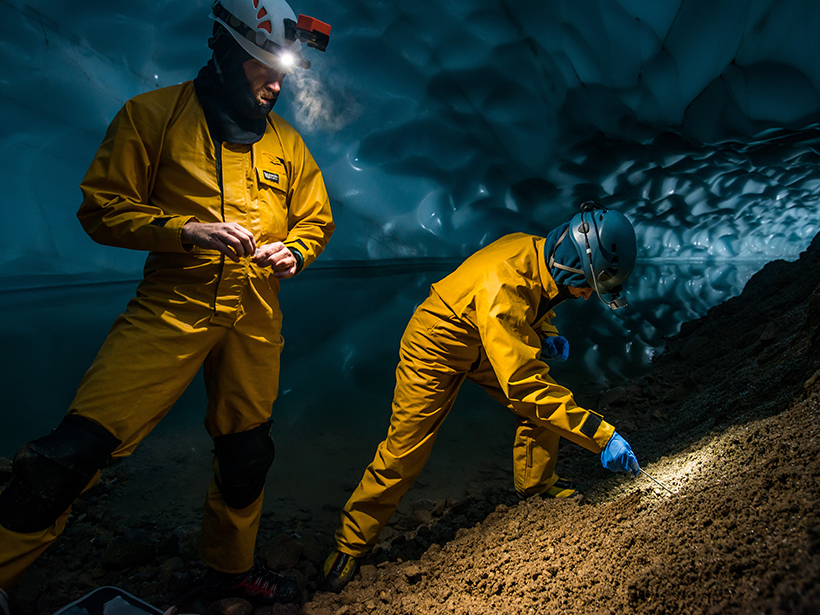A labyrinth of icy caves snakes for several kilometers through the glaciers near the 4,400-meter-high summit of Mount Rainier in Washington State. Explorers recently returned from an expedition to map and study these fumarole caves, named after the volcanic vents that release the searing gases that excavate the tunnels. The caves’ icy environs are an excellent analogue, members of the exploration team said, for moons in the far reaches of the solar system that might be good places to search for life.
This past summer, a dozen researchers with the Mt. Rainier Fumarole Cave Project spent 6 days exploring the caves. They investigated a lake within the labyrinth that they found hovers continuously near, and occasionally below, freezing. They also collected soil samples for microbial analysis and measured chemical properties of the caves’ ice. As they had done in the past, project members also used the caves as testing grounds for technology that might one day find use in space missions to other worlds like Jupiter’s moon Europa.
“There’s no single surface within the [fumarole] caves that’s stable.”
The caves present both a fascination and a danger for the explorers. The constant release of hot plumes of volcanic gases from within the mountain continuously changes the shapes and pathways of the caves, said mountaineer Eddy Cartaya, the project’s coordinator and cofounder and a law enforcement officer with the U.S. Forest Service at Deschutes National Forest in Oregon. Unlike relatively permanent rock caves, “there’s no single surface within the [fumarole] caves that’s stable,” he reported last month at the 129th Annual Meeting of the Geological Society of America held in Seattle, Wash.
Natural Laboratory
The project’s scientists are keen to explore these caves despite substantial risks and the physical and technical challenges of climbing Washington State’s highest mountain. That’s because they’re a “natural laboratory” for investigating not only distant icy worlds but also the many places on Earth where volcanism and ice meet, said Tabbatha Cavendish, a geoscientist and park ranger at Mount Rainier National Park who is involved in the project.
This kind of work is “giving us deeper insights into subsurface volcanic processes and the microorganisms that are extremely adapted to survive and thrive under harsh conditions.”
This kind of work is “giving us deeper insights into subsurface volcanic processes and the microorganisms that are extremely adapted to survive and thrive under harsh conditions,” said George Veni, executive director of the National Cave and Karst Research Institute in Carlsbad, N.M., who was not involved in the research.
Hidden Lake
The Mt. Rainier Fumarole Cave Project began in 2015 with major funding from the National Geographic Expeditions Council. Since then, team members have explored and mapped roughly 4 kilometers of cave passages within Mount Rainier’s summit glaciers.
In 2016, the explorers placed a sensor in the labyrinth’s internal lake, known as Lake Adelie, which is North America’s highest lake, to record water level, temperature, and conductivity at 15-minute intervals. Upon returning to the lake this past summer, they found that “we couldn’t get the sensor out because rocks had shifted and it was now wedged between boulders,” said Lee Florea, a hydrogeologist at Indiana University in Bloomington and principal investigator of hydrogeology and geochemistry with the Mt. Rainier Fumarole Cave Project.
Florea and his colleagues decided to use a selfie stick as a hook and managed to finally free the sensor after 2 days of work. Its readings revealed that Lake Adelie’s blue waters fluctuated minimally in temperature: They typically remained colder than 0.5°C and sometimes froze.
What little fluctuation in water temperature there was seemed to occur in concert with changes in the caves’ atmosphere, Florea said. “When there is a major storm event, temperatures on the summit plunge, and snow seals off the entrances to the caves, trapping in heat,” he explained.
An Ice-Climbing Bot
During earlier expeditions to the fumarole caves, project scientists had also used the labyrinth to try out components of futuristic rovers, like the one NASA is considering sending to Europa. “Traditional wheeled rovers are probably not the best design for mobility” needed by such missions, said Aaron Curtis, a volcanologist at NASA’s Jet Propulsion Laboratory in Pasadena, Calif. “Rovers will soon need a way to get around on rugged, icy terrain.”
Curtis brought an ice-climbing robot to Mount Rainier this past July and August and demonstrated the success of robotic “hands” containing ice screws. He showed that the fasteners penetrated into the icy walls and ceilings of the fumarole caves, providing a grip strong enough to hold the robot and a backpack.

Danger and Debris
Entrances to Mount Rainier’s fumarole caves can be clearly seen at the summit, and escaping steam often beckons curious climbers. However, despite its exotic beauty, the labyrinth poses a host of perils, project scientists warned. “You don’t dare go down there without a gas monitor and multiple sources of light,” said Cartaya. In addition to the very real danger of getting lost, pools of carbon dioxide gas persist in some lower passages of the caves. “A couple of breaths and you’d pass out,” cautioned Florea.
Despite the relative isolation of the caves—fewer than 5,000 people summited Mount Rainier in 2015—humans have left a noticeable mark on the terrain. Anything dropped on the mountain is slowly absorbed into the glaciers and carried down as new snow is deposited and the underlying ice melts from the bottom up, explained Florea. In 10 or 15 years, it rains out of the ceiling of the caves. “What you see now is hundreds of tent stakes, canteens, and busted stoves,” Cartaya added. “It’s literally raining garbage inside the caves.”
What’s Next?
The Mt. Rainier Fumarole Cave Project team hopes to return to the mountain next summer to collect more data. One “big nugget” that’s still missing is information about airflow within the caves, said Florea. By measuring wind speed and temperature, the team hopes to better understand how gases cycle through the caves, which in turn affects the overall environment. “Wind is like the bloodstream of the cave,” said Cartaya. “You need to know how it flows.”
—Katherine Kornei (email: [email protected]; @katherinekornei), Freelance Science Journalist
Citation:
Kornei, K. (2017), Ice caves atop a volcano give taste of otherworldly science, Eos, 98, https://doi.org/10.1029/2017EO087819. Published on 30 November 2017.
Text © 2017. The authors. CC BY-NC-ND 3.0
Except where otherwise noted, images are subject to copyright. Any reuse without express permission from the copyright owner is prohibited.

